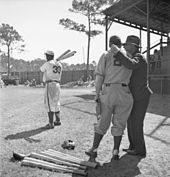Minor leagues
In 1946, Robinson arrived at Daytona Beach, Florida, for spring training with the Montreal Royals of the Class AAA International League (the designation of "AAA" for the highest level of minor league baseball was first used in the 1946 season). Clay Hopper, the manager of the Royals, asked Rickey to assign Robinson to any other Dodger affiliate, but Rickey refused.[102]
Robinson's presence was controversial in racially charged Florida. As he was not allowed to stay with his teammates at the team hotel, he lodged instead at the home of a local black politician.[103][104] Since the Dodgers organization did not own a spring training facility (the Dodger-controlled spring training compound in Vero Beach known as "Dodgertown" did not open until spring 1948),[105] scheduling was subject to the whim of area localities, several of which turned down any event involving Robinson or Johnny Wright, another black player whom Rickey had signed to the Dodgers' organization in January. In Sanford, Florida, the police chief threatened to cancel games if Robinson and Wright did not cease training activities there; as a result, Robinson was sent back to Daytona Beach.[106][107] In Jacksonville, the stadium was padlocked shut without warning on game day, by order of the city's Parks and Public Property director.[108][109] In DeLand, a scheduled day game was called off, ostensibly because of faulty electrical lighting.[110][111]
After much lobbying of local officials by Rickey himself, the Royals were allowed to host a game involving Robinson in Daytona Beach.[112][113]Robinson made his Royals debut at Daytona Beach's City Island Ballpark on March 17, 1946, in an exhibition game against the team's parent club, the Dodgers. Robinson thus became the first black player to openly play for a minor league team against a major league team since thede facto baseball color line had been implemented in the 1880s.[2] Later in spring training, after some less-than-stellar performances, Robinson was shifted from shortstop to second base, allowing him to make shorter throws to first base.[62] Robinson's performance soon rebounded. On April 18, 1946, Roosevelt Stadium hosted the Jersey City Giants' season opener against the Montreal Royals, marking the professional debut of the Royals' Jackie Robinson and the first time the color barrier had been broken in a game between two minor league clubs.[114] Pitching against Robinson was Warren Sandel who had played against him when they both lived in California. During Robinson's first at bat, the Jersey City catcher, Dick Bouknight, demanded that Sandel throw at Robinson, but Sandel refused. Although Sandel induced Robinson to ground out at his first at bat, in his five trips to the plate, Robinson ended up with four hits, including his first hit, a three-run home run, in the game's third inning.[115] He also scored four runs, drove in three, and stole two bases in the Royals' 14–1 victory.[116] Robinson proceeded to lead the International League that season with a .349 batting average and .985 fielding percentage,[20] and he was named the league's Most Valuable Player.[117] Although he often faced hostility while on road trips (the Royals were forced to cancel a Southern exhibition tour, for example),[62] the Montreal fan base enthusiastically supported Robinson.[118][119] Whether fans supported or opposed it, Robinson's presence on the field was a boon to attendance; more than one million people went to games involving Robinson in 1946, an amazing figure by International League standards.[120] In the fall of 1946, following the baseball season, Robinson returned home to California and briefly played professional basketball for the short-lived Los Angeles Red Devils.[121][122]


No comments:
Post a Comment